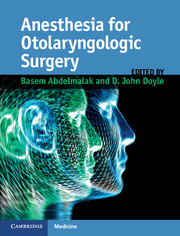Book contents
- Anesthesia for Otolaryngologic Surgery
- Anesthesia for Otolaryngologic Surgery
- Copyright page
- Dedication
- Contents
- Foreword
- Foreword 2
- Contributors
- Preface
- Section 1 Introduction
- Section 2 Anesthesia for nasal, sinus and pituitary surgery
- Section 3 Anesthesia for head and neck surgery
- Section 4 Anesthesia for laryngotracheal surgery
- Chapter 26 Anesthesia for laryngoplasty
- Chapter 27 Anesthesia for tracheotomy
- Chapter 28 Anesthesia for the management of subglottic stenosis and tracheal resection
- Chapter 29 Anesthesia for otologic and neurotologic surgery
- Section 5 Anesthesia for bronchoscopic surgery
- Section 6 Anesthesia for Pediatric ENT Surgery
- Index
Chapter 26 - Anesthesia for laryngoplasty
from Section 4 - Anesthesia for laryngotracheal surgery
Published online by Cambridge University Press: 05 November 2012
- Anesthesia for Otolaryngologic Surgery
- Anesthesia for Otolaryngologic Surgery
- Copyright page
- Dedication
- Contents
- Foreword
- Foreword 2
- Contributors
- Preface
- Section 1 Introduction
- Section 2 Anesthesia for nasal, sinus and pituitary surgery
- Section 3 Anesthesia for head and neck surgery
- Section 4 Anesthesia for laryngotracheal surgery
- Chapter 26 Anesthesia for laryngoplasty
- Chapter 27 Anesthesia for tracheotomy
- Chapter 28 Anesthesia for the management of subglottic stenosis and tracheal resection
- Chapter 29 Anesthesia for otologic and neurotologic surgery
- Section 5 Anesthesia for bronchoscopic surgery
- Section 6 Anesthesia for Pediatric ENT Surgery
- Index
Summary
Keywords
- Type
- Chapter
- Information
- Anesthesia for Otolaryngologic Surgery , pp. 245 - 254Publisher: Cambridge University PressPrint publication year: 2012

